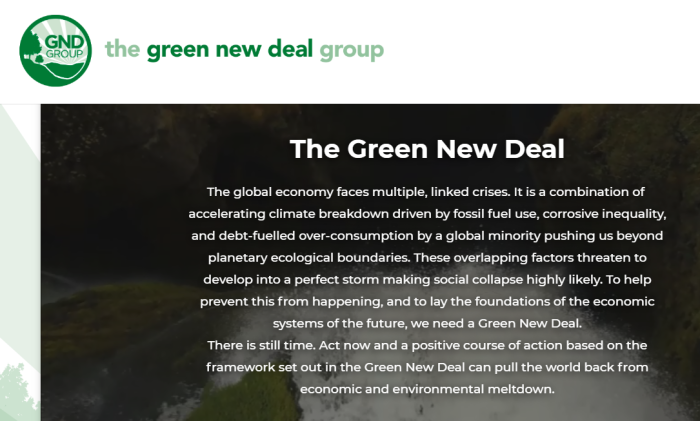
Think recent public efforts to convince the public to act on climate change just happened? No, they are the result of years of planning, and from an organization called Green New Deal Group.
There is some real strategy at play here. Divert people’s attention with protests, riots, and public movements, and the agenda can be quietly passed. After all, how much coverage do the various treaties we sign (and bills we pass), actually get?
1. About Green New Deal Group
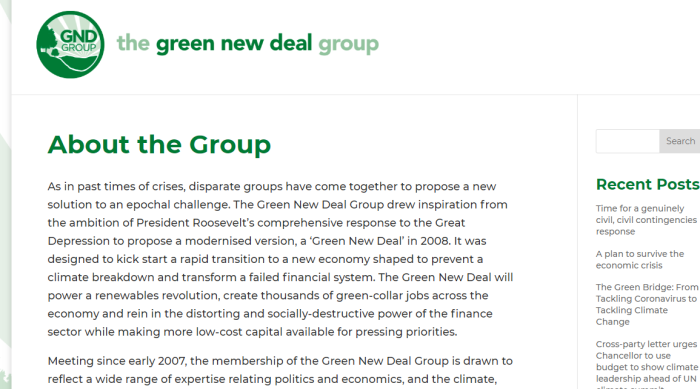
As in past times of crises, disparate groups have come together to propose a new solution to an epochal challenge. The Green New Deal Group drew inspiration from the ambition of President Roosevelt’s comprehensive response to the Great Depression to propose a modernised version, a ‘Green New Deal’ in 2008. It was designed to kick start a rapid transition to a new economy shaped to prevent a climate breakdown and transform a failed financial system. The Green New Deal will power a renewables revolution, create thousands of green-collar jobs across the economy and rein in the distorting and socially-destructive power of the finance sector while making more low-cost capital available for pressing priorities.
Meeting since early 2007, the membership of the Green New Deal Group is drawn to reflect a wide range of expertise relating politics and economics, and the climate, nature and inequality crises. The views and recommendations of the Green New Deal series of reports, are those of the group writing in their individual capacities.
The Green New Deal Group is, in alphabetical order:
.
Larry Elliott, Economics Editor of the Guardian, Colin Hines, Co-Director of Finance for the Future, former head of Greenpeace International’s Economics Unit, Jeremy Leggett, founder and Chairman of Solarcentury and SolarAid, Clive Lewis, Labour MP, Caroline Lucas, Green Party MP, Richard Murphy, Professor of Practice, City University, Director Tax Research LLP, Ann Pettifor, Director, Policy Research in Macroeconomics (PRIME), Charles Secrett, Advisor on Sustainable Development, former Director of Friends of the Earth, Andrew Simms, Co-Director, New Weather Institute, Coordinator, The Rapid Transition Alliance, Assistant Director, Scientists for Global Responsibility. Geoff Tily Senior Economist, TUC
Those are the people who make up the Green New Deal Group. In essence, this is the brainchild behind the eco movement in recent years.
2. GNDG Used To Reboot After 2008 Crash
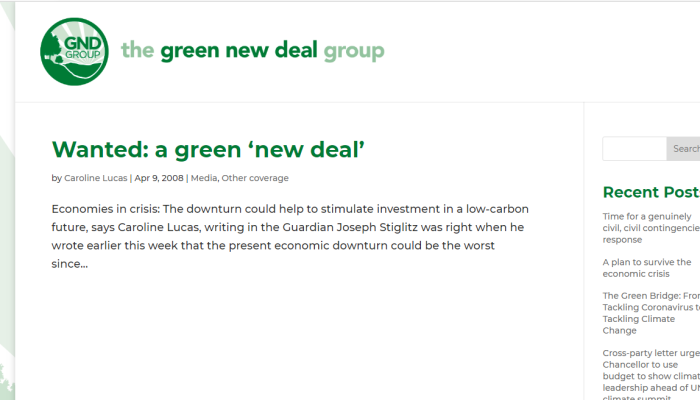
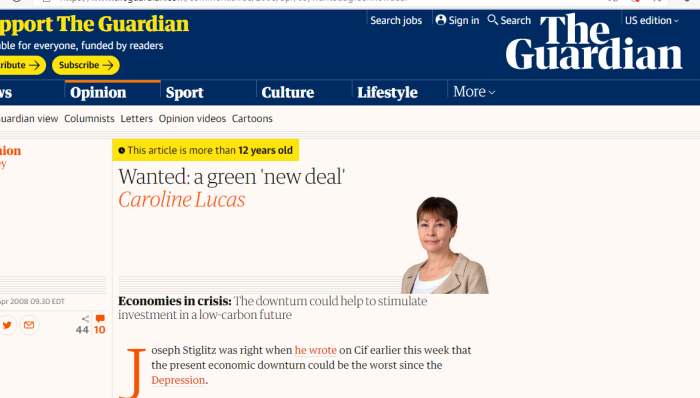
In the coverage of the causes and likely future effects of the credit crunch, such grim parallels are becoming commonplace. But it’s now time to move from problems to solutions, and here too the Depression can form a useful reference point. Franklin Roosevelt’s action programme for dealing with the aftermath of the late 1920s credit crunch was threefold: first, strictly regulate the cause of the problem – the greedy and feckless finance sector; second, get people back to work, and generate business opportunities by a New Deal. This invested billions of dollars in training, better working conditions and a huge range of infrastructural projects such as highways, dams and bridges. Finally, fund this in part by an increase in taxes on big business and the rich – a measure which also had the positive effect of dramatically decreasing inequality.
Today the re-regulation of finance is even being discussed among consenting free market adults in the columns of the Financial Times. My colleague, environmentalist Colin Hines, has fleshed out the details of a Green New Deal which could help re-boot the economy after the credit crash, while putting serious money into addressing climate change.
As a result of the 2008 crash, this group decided that it would make a great opportunity to completely remake their economy, and deal with climate change in the first place. They reasoned that if banks were worth pouring trillions into, then the environment must be as well. The argument does have some merit to it.
Notice that it’s compared to the “New Deal” that Franklin Delano Roosevelt launched in the 1930s. This is not the last time that comparison will come up.
Alexandria Ocasio-Cortez introduced the U.S. public to the Green New Deal in 2019, just after taking office. It wasn’t some brainstorm she had, but had been drawn up many years ago. The YouTuber, Mr. Reagan, did address that AOC was a puppet, but he missed how far back the plan went.
3. GND Group To Solve “Triple Crunch”

Can I trust the bank to look after my money? Clickety clack. How much has my house fallen in value? Clickety clack. Will high fuel prices mean I can’t keep my car on the road? Can I afford to buy enough food for the family? Clickety clack. Will I lose my job, and why is everyone making me paranoid about climate change when there’s nothing I can do about it? Clickety, clickety clack … and then back to the beginning. The “triple crunch” of a credit-fuelled financial crisis, accelerating climate change and soaring energy prices – how did we get into this mess? In the face of so many simultaneous crises, we all have legitimate questions for the governments that allowed us to sleepwalk into this situation.
The Green New Deal was dreamed up as a way to solve multiple problems, such as: (a) financial crisis; (b) climate change; and (c) energy prices all at once.
While it’s nice to see the financial crisis addressed, this group seems to miss the elephant in the room: central banking. It’s that the Government legislates in such a way that the U.S. is forced to borrow — at interest — from the Federal Reserve, a private organization. Do they not know about any of this?
4. History Of The Green New Deal
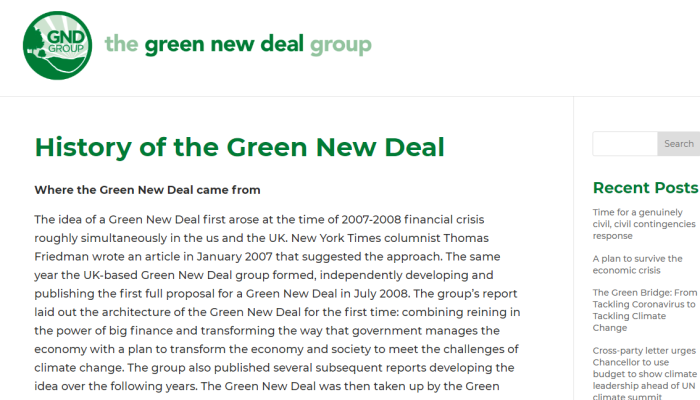
Where the Green New Deal came from
.
The idea of a Green New Deal first arose at the time of 2007-2008 financial crisis roughly simultaneously in the us and the UK. New York Times columnist Thomas Friedman wrote an article in January 2007 that suggested the approach. The same year the UK-based Green New Deal group formed, independently developing and publishing the first full proposal for a Green New Deal in July 2008. The group’s report laid out the architecture of the Green New Deal for the first time: combining reining in the power of big finance and transforming the way that government manages the economy with a plan to transform the economy and society to meet the challenges of climate change. The group also published several subsequent reports developing the idea over the following years. The Green New Deal was then taken up by the Green Party in the UK, by Green parties across Europe and by the United Nations Environment Programme. In 2018, the idea was revived by us senator Alexandria Ocasio-Cortez and the Sunrise Movement in the US following a meeting between a member of her team and UK Green New Deal group member Ann Pettifor. When AOC published a bill for the Green New Deal with Senator Edward Markey in February 2019 the idea caught on around the world.
Far from being some sort of a revolutionary, AOC was simply the latest person assigned to run with the agenda. While it is easy to mock the GND outright, it seems that elements of it are embedded within Agenda 2030 and the Great Reset.
5. UK PM Gordon Brown Promotes GND

Moving the UK to a low-carbon economy will create 400,000 new jobs over the next eight years, Gordon Brown has told a summit in London.
.
The prime minister called for an international “green new deal” to boost the environmental sector and help lift the global economy out of recession.
.
This will increase “confidence and certainty”, he added.
.
But unions and environmental groups called for more funding for green projects, along with better regulation.
The government has set a target of reducing greenhouse gas emissions by 80% from 1990 levels by 2050.
When he was Prime Minister of the UK, Gordon Brown openly called for a “Green New Deal” to rebuild the country after the banking collapse.
6. Green Quantitative Easing

As the Bank of England moves closer towards announcing an unprecedented third round of ‘Quantitative Easing’, experts are calling for this newly created money to be used more productively and effectively to achieve key social and environmental objectives. During the last round of Quantitative Easing (’QE’) the Bank of England purchased £275bn worth of government bonds with money it newly created. As the Bank of England prepares the ground to inject a likely £50bn to £75bn into the economy, the UK’s Green Party MP, Caroline Lucas, and Southampton University banking expert Professor Richard Werner, are calling for this money injection to be used for green projects that directly improve the environment and long-term quality of life, while creating many new jobs. Said Professor Richard A. Werner, Director of the Centre for Banking, Finance and Sustainable Development at the University of Southampton: “Many people would like money creation to be used to help the wider economy directly and to implement some badly needed green projects that would enhance the sustainability of the economy and improve the environment—as well as create new jobs.”
Green Quantitative Easing Paper
In 2012, Richard Werner submitted a proposal for “green quantitative easing”. In short, it would still involve printing off large sums of money. However, it would be spent on environmental causes, instead of being poured into banks.
7. GND Group UK Budget Submission
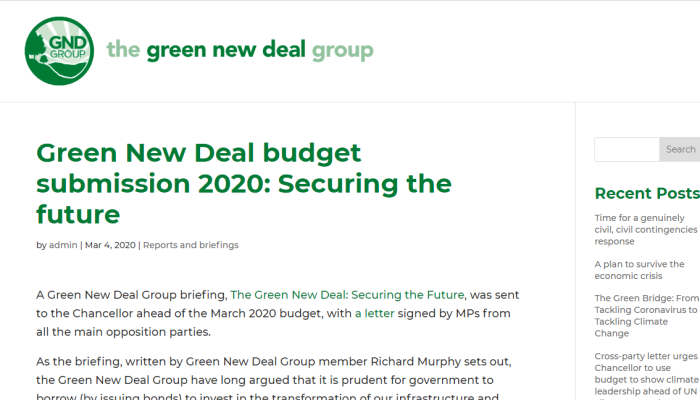
A Green New Deal Group briefing, The Green New Deal: Securing the Future, was sent to the Chancellor ahead of the March 2020 budget, with a letter signed by MPs from all the main opposition parties.
As the briefing, written by Green New Deal Group member Richard Murphy sets out, the Green New Deal Group have long argued that it is prudent for government to borrow (by issuing bonds) to invest in the transformation of our infrastructure and businesses while interest rates are low. The briefing shows how such government borrowing could be financed in a way that also creates a safe place for the nation’s pensions and savings, by making simple changes to existing tax incentives. Much of the £70bn saved annually in ISAs could then be invested in government-backed green bonds at an interest rate of 1.85% (the UK government’s current average cost of borrowing) and a quarter of the £100bn currently invested in pensions could be directed into Green New Deal investment.
A budget proposal was submitted to the UK Government in March 2020. It was written by the Green New Deal Group, and was able to get the signatures of many politicians.
8. Protests/Riots Partly Entirely For Show
In recent years, there have been loud environmental movements going on across the Western World. There have been efforts to shut down industries, pipelines, and society altogether. These people seem oblivious to the fact that shutting down oil (for example), would lead to a drastic reduction in their living standards.
However, this is a sleight of hand. Even though politicians appear to be turned off by the antics of violent protesters, they work behind the scenes to ensure that the goals are enacted anyway. Treaties such as Agenda 21, Agenda 2030, and the Great Reset are designed to achieve many of the same goals.
BOLD Like A Leopard wrote a great piece on some of the forces acting behind the scenes. It’s well worth the time to read.
Now we look at the bigger picture. While the public is distracted by very visible protests over environmental issues, just quietly implement them behind the scenes. People likely won’t notice. They are too focused on radicals who seem hell bent on destabilization, though those are distractions.
9. Bankers Run Climate Change Movement
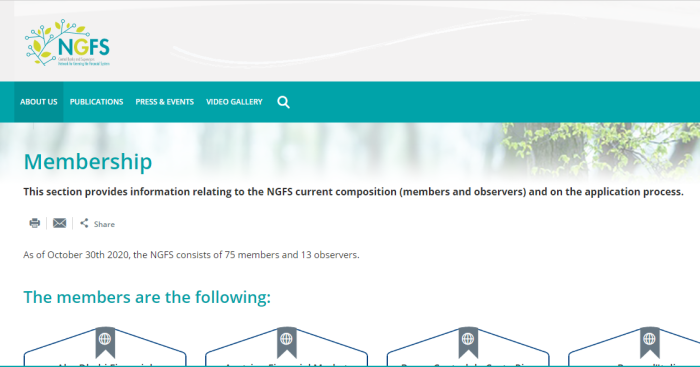
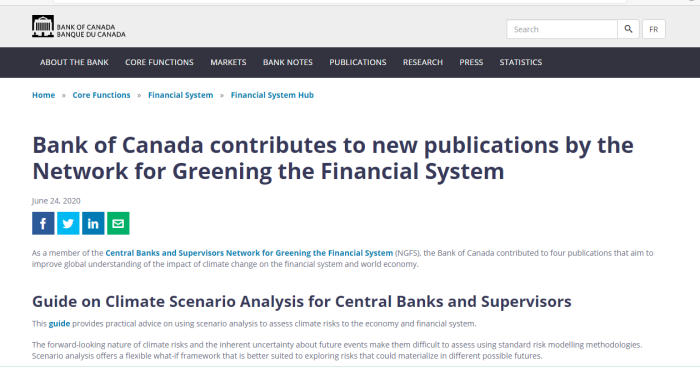
This will seem a cruel twist, but central banks are heavily behind the green movement. One such group is the Network for Greening the Financial System, which currently boasts 75 members.
Hard to be part of the resistance when the financial sector supports, (or at least appears to support), green initiatives. It’s unclear, however, if the banks simply co-opted the movement, or whether they were always running things from behind the scenes.
Green New Deal Group Main Page
https://archive.is/ncRvA
WayBack Machine Archives
About Us: Green New Deal Group
https://archive.is/rxRpv
WayBack Machine Archive
https://greennewdealgroup.org/2008/04/
Guardian 2008: We Wanted A Green New Deal
https://greennewdealgroup.org/2008/07/
Guardian 2008 Article On The Triple Crunch
https://greennewdealgroup.org/2009/03/
Gordon Brown Calls For Global Green New Deal
https://greennewdealgroup.org/2009/07/
The Ecologist: Bailed Out Banks Should Fund GND
Green New Deal Group Budget Proposal
Network For Greening The Financial System
AOC: This Is Our World War II
Mr. Reagan: The Brains Behind AOC
NBC On Sunrise Movement
